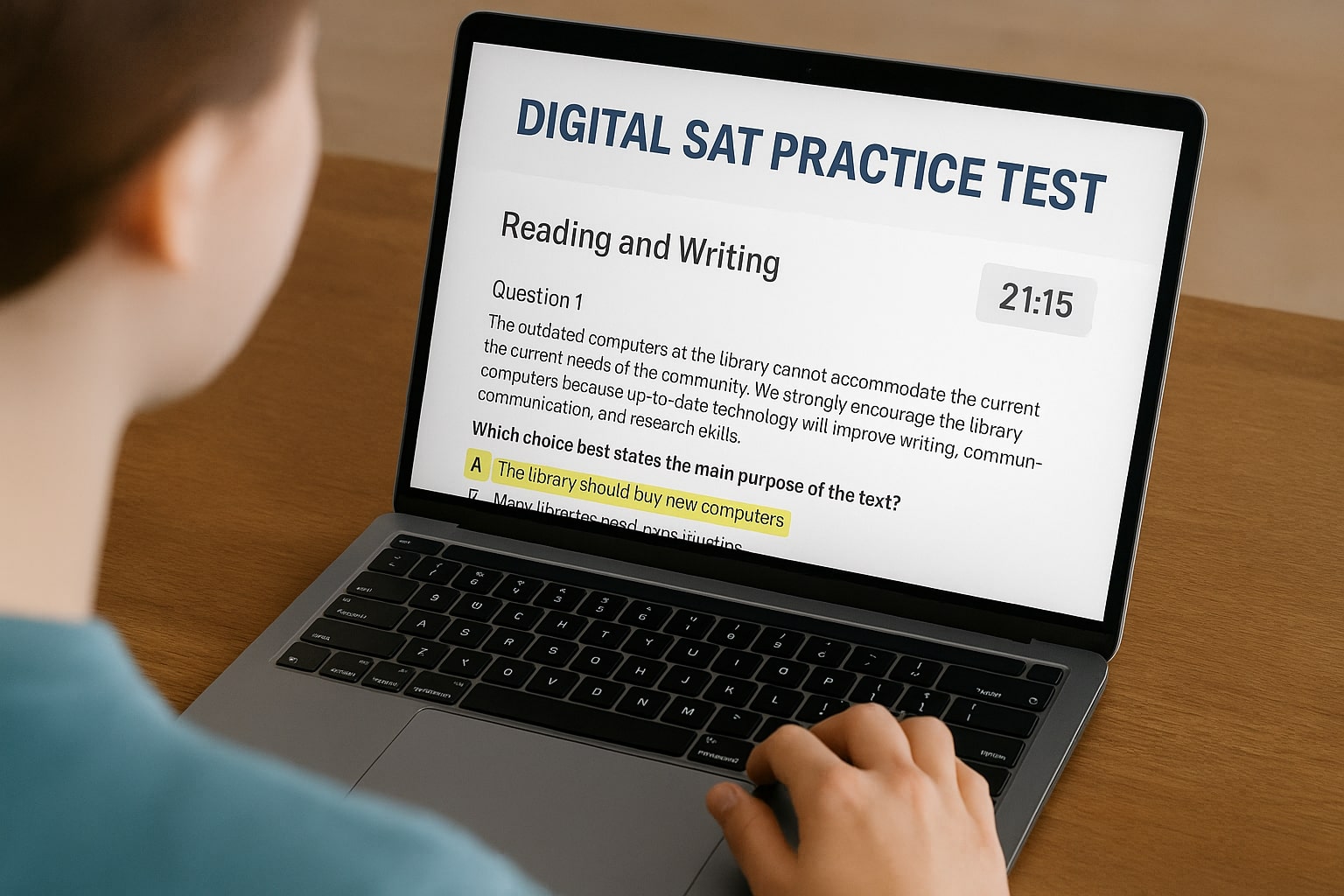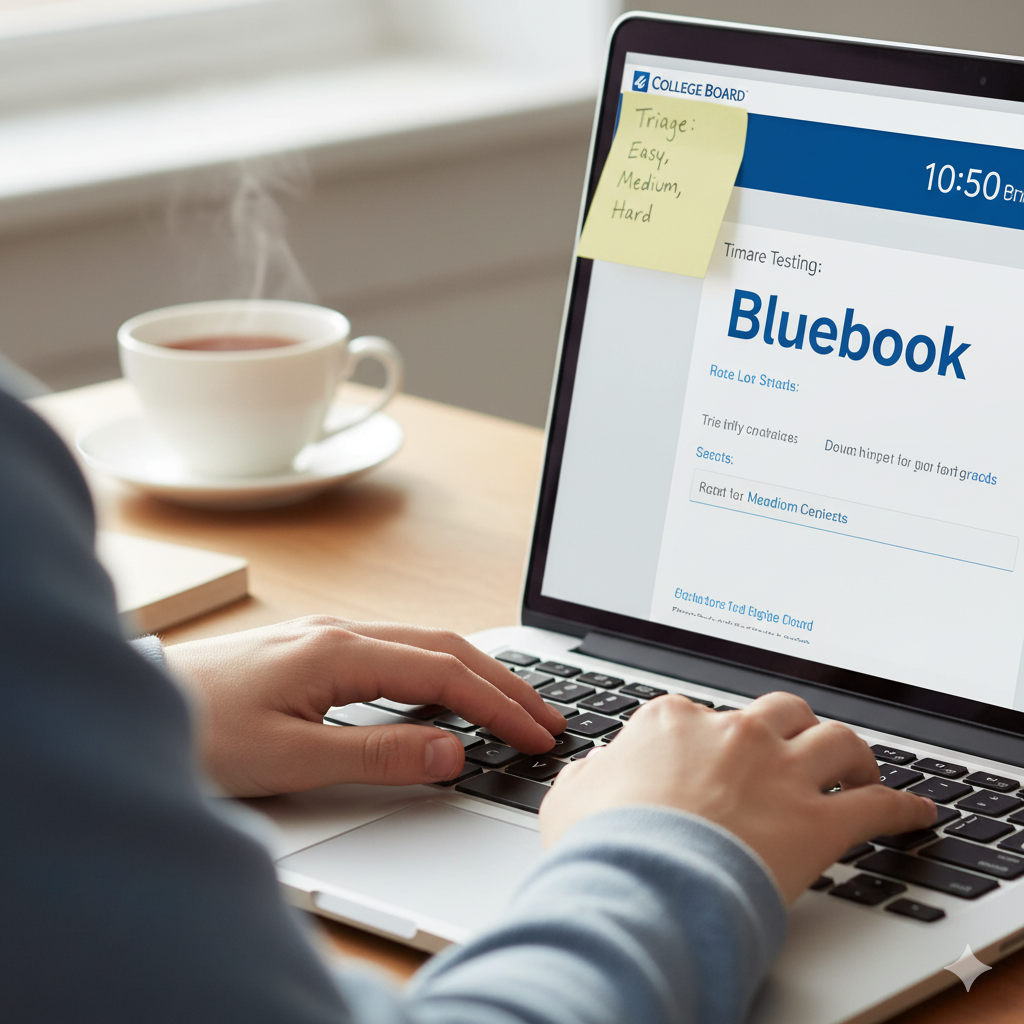Why balancing accuracy and speed matters on the Digital SAT
Imagine two students sitting in the same testing room. One moves cautiously, answering each question with care but running out of time on the last module; the other races through questions, leaving a trail of careless mistakes. The Digital SAT, with its adaptive format and built-in testing tools, rewards a third approach: deliberate speed. That’s a rhythm where you’re fast enough to reach every question but accurate enough that your time isn’t wasted fixing careless errors. That sweet spot — where accuracy and speed meet — is what you want to train for.
What’s different about timing on the digital format?
The Digital SAT is shorter overall than the old paper SAT, but it’s split into two modules per section, and it’s adaptive: your performance in the first module influences the difficulty of the second. This structure means two things for pacing: first, you generally have more time per question than before, and second, how you perform early changes the set of questions you’ll face later. Because of this, a good strategy isn’t just about finishing fast — it’s about performing consistently from the start so you get the right second-module level to showcase your strengths.
Quick facts to keep in mind
- Total time: about 2 hours 14 minutes (two sections: Reading & Writing, and Math).
- Each section has two modules — your first-module performance affects your second module.
- Built-in tools like the digital calculator and a line reader are available; practice with them so they help, not slow you down.

Mindset first: accuracy and speed are partners, not enemies
The single most important change you can make in your prep is to stop treating accuracy and speed as conflicting goals. They aren’t. Speed without accuracy is reckless; accuracy without speed is incomplete. Think of them as teammates: accuracy builds a reliable foundation (right answers), while speed makes sure you can showcase all your knowledge within the testing window.
How smart students think about practice
- Start slow to build accuracy: understand question types, common traps, and why correct answers are correct.
- Introduce timing gradually: once you’re accurate, shave off seconds per question through strategies and repetition.
- Simulate test conditions: use full-length Bluebook-style practice tests to get used to the tools and pacing.
Concrete strategies to improve accuracy
Accuracy is about fewer careless mistakes and a clearer approach to problem-solving. Here are practical steps you can use immediately.
1. Read the question, then the passage/figure
For Reading & Writing, read the question stem first for certain question types (like locating evidence or line references). For Math, scan the question to know what’s being asked before you start algebraic steps; this avoids doing unnecessary work.
2. Make the easy checks routine
- Do a quick units check in math problems—does the answer make sense dimensionally?
- In Reading, eliminate answers that directly contradict the passage.
- On multiple-choice math, estimate whether the numeric answer is plausible before selecting or inputting it.
3. Use the digital tools to your advantage
The testing platform includes a line reader, highlight function, and an embedded calculator. Learn keyboard shortcuts if any are available in practice, and develop a habit: highlight key phrases and use the line reader to reduce re-reading, which saves time and increases focus.
4. Learn common trap patterns
Many errors happen because you fall for predictable traps—misreading negatives, overlooking “except” in a question stem, or misplacing a decimal. Make a short cheat-sheet of traps and review it after every practice section to internalize them.
Concrete strategies to increase speed without sacrificing accuracy
Speed comes from practice and from smarter work — not from frantic rushing. The techniques below will help you reduce wasted time while keeping your answer quality high.
1. Master question triage
Don’t spend more than a fixed amount of time on any single question during your first pass. Here’s a simple triage rule you can practice:
- Easy — solve now (expected time: short)
- Medium — mark and return (expected time: moderate)
- Hard/confusing — mark and revisit only after first pass (expected time: last-resort)
2. Use timed micro-drills
Instead of only running full practice tests, add micro-drills: sets of 8–12 questions focused on a single skill (algebra, sentence structure, evidence-based reading) with a strict time cap. These build the muscle for quick recall and reduce decision-making time on test day.
3. Learn shortcuts and estimation
For many math questions, exact arithmetic isn’t necessary. Use estimation, back-solving from answer choices, or plugging in numbers to test expressions faster. For reading, skimming for structure (topic sentence, transition words, examples) often gives you the right answer faster than line-by-line reading.
4. Practice with the actual testing environment
Bluebook practice replicates the tools and layout you’ll face on test day. Spend time practicing within this environment so you don’t lose time learning the interface while the timer is running.
Sample weekly plan to balance both goals (8-week timeline)
The following plan alternates accuracy-focused work with speed work. Personalize it: if you already have strong math accuracy, shift more time toward reading speed drills.
| Week | Focus | Activities | Weekly Goal |
|---|---|---|---|
| 1 | Foundations — Accuracy | Diagnostic test; identify top 3 weak areas; targeted practice on core concepts. | Understand error types; baseline score. |
| 2 | Accuracy deepening | Micro-drills; targeted lessons; review mistakes in detail. | Reduce conceptual errors by 30% in drills. |
| 3 | Introduce speed | Timed micro-drills + accuracy check; practice Bluebook tools. | Answer faster with same accuracy in drills. |
| 4 | Full practice + analysis | One full-length Bluebook practice test; deep review of missed items. | Improve pacing across modules. |
| 5 | Targeted speed work | Back-to-back timed sets; develop triage habit; calculator efficiency drills. | Reduce average time per question. |
| 6 | Mixed practice | Alternate accuracy-focused sessions and timed sessions; practice stress-management techniques. | Consistency under time pressure. |
| 7 | Simulation week | Two full-length Bluebook practices under test conditions; focus on stamina and timer usage. | Match target pacing across entire test. |
| 8 | Polish and review | Light practice, error review, and final mini-drills. Mental readiness work. | Enter test day calm, practiced, and confident. |
How to track progress: metrics that matter
Tracking the right metrics is essential — otherwise you’ll grind without direction. Here are meaningful numbers to watch:
- Accuracy by question type (e.g., main idea, function, algebraic manipulation).
- Average time per question by type.
- Percentage of first-pass completion (how many questions you answer or mark on first pass).
- Score trends on full-length practice tests.
Example weekly tracking table
| Metric | Week 1 | Week 4 | Week 8 |
|---|---|---|---|
| Accuracy (overall) | 68% | 75% | 84% |
| Avg time per Reading question | 1:05 | 0:52 | 0:45 |
| Avg time per Math question | 1:40 | 1:25 | 1:10 |
| First-pass completion | 60% | 75% | 90% |
Common pitfalls and how to avoid them
A few recurring mistakes derail smart students more often than poor preparation does. Here’s what to watch for.
Pitfall: obsessing over speed without addressing weak concepts
Solution: isolate conceptual gaps first. Speed will follow when you’re not guessing because you don’t understand a concept.
Pitfall: relying on one practice test provider
Solution: prioritize official Bluebook practice to learn the interface and question style, but supplement with a variety of question banks for additional exposure. Consistency between your practice and the real test environment helps reduce avoidable interface-related errors on test day.
Pitfall: ignoring the first module
Solution: treat the first module as a launching pad. Avoid spending extra time trying to “show” ability with a few hard questions; steady, accurate performance opens a better second module.
How tutoring and personalized guidance can help — when it fits
Many students see measurable improvements when they combine self-study with targeted, personalized support. A good tutor or coaching program focuses on your specific error patterns, tailors drills to your weak spots, and helps you practice pacing strategies in a way that matches how you think and learn.
If you’re considering personalized help, look for offerings that include 1-on-1 guidance, tailored study plans, and tools that analyze your practice data so sessions are efficient. For example, Sparkl’s personalized tutoring emphasizes one-on-one support, tailored study plans, and AI-driven insights that help pinpoint where time is being lost and how accuracy can be improved quickly. Such services are especially helpful if you’ve plateaued on your own and want structured, high-impact practice.
Test-day micro-routines for calm, accurate performance
Test day is a performance, and micro-routines reduce cognitive friction so you can execute. These are short rituals you can practice in final weeks.
- 10 minutes before the test: deep belly breaths and a quick review of a one-page error-pattern checklist (common traps you still make).
- First 5 minutes of each module: quick scan of the tool layout (calculator, line reader, mark-for-review). Confirm your triage rule in your head (e.g., 90 seconds max on an easy-flagged item).
- When you finish a question: do a 3-second plausibility check — does the answer look reasonable? If not, mark and return.

Real-world examples: small changes that yield big score gains
Example 1: A student shaving 15 seconds off average math questions. By learning back-solving and answer-estimation techniques, they reduced time per question from 1:40 to 1:20 and avoided wild-guess errors. The net effect across 44 math questions was finishing comfortably with fewer mistakes, producing a noticeable band jump on practice tests.
Example 2: A reader improving comprehension accuracy. By switching to a question-before-passage strategy for line-reference questions and using the line reader tool, the student cut re-read time and eliminated careless misinterpretation. That led to improved consistency across Reading modules, which in turn supported a stronger adaptive second module.
Final checklist for balanced prep
- Practice in Bluebook to master the interface and built-in tools.
- Use micro-drills for speed and targeted sessions for accuracy.
- Track and improve specific metrics: accuracy by type and average time per question.
- Simulate full test conditions often and analyze every mistake carefully.
- Consider personalized tutoring if you need tailored pacing strategies or a focused study plan — services that include 1-on-1 coaching and data-driven feedback can accelerate improvement.
Parting thought: build habits, not hacks
There’s no single trick that makes accuracy and speed magically align. It’s a process: understand the test, train deliberately, and let data guide practice. Build habits — triage, plausibility checks, using Bluebook tools — and those habits will serve you on test day more than last-minute cram tricks ever will.
Take one small step today
Pick one accuracy habit and one speed habit to practice this week. Maybe it’s “highlight one sentence per paragraph” for reading and “back-solve two algebra problems” for math. Practice them in timed micro-drills and watch how steady gains add up. Balanced preparation is about patience, practice, and the right kind of help when you need it.
Good luck — with consistency and a clear plan, you’ll arrive on test day confident that you can be both accurate and fast. That’s when the Digital SAT stops feeling like a race and starts feeling like an exam you know how to ace.






















No Comments
Leave a comment Cancel